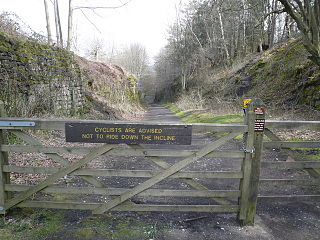Related Research Articles

The Cromford and High Peak Railway (C&HPR) was a standard-gauge line between the Cromford Canal wharf at High Peak Junction and the Peak Forest Canal at Whaley Bridge. The railway, which was completed in 1831, was built to carry minerals and goods through the hilly rural terrain of the Peak District within Derbyshire, England. The route was marked by a number of roped worked inclines. Due to falling traffic, the entire railway was closed by 1967.

The High Peak Trail is a 17-mile (27 km) trail for walkers, cyclists and horse riders in the Peak District of England. Running from Dowlow (53.2059°N 1.8349°W), near Buxton, to High Peak Junction, Cromford (53.1004°N 1.5354°W), it follows the trackbed of the former Cromford and High Peak Railway, which was completed in 1831 to carry minerals and goods between the Cromford Canal wharf at High Peak Junction and the Peak Forest Canal at Whaley Bridge.

Cromford railway station is a Grade II listed railway station owned by Network Rail and managed by East Midlands Railway. It is located in the village of Cromford in Derbyshire, England. The station is on the Derwent Valley Line 15+1⁄2 miles (24.9 km) north of Derby towards Matlock.

Whatstandwell railway station is a railway station owned by Network Rail and managed by East Midlands Railway. It serves the villages of Whatstandwell and Crich Carr in Derbyshire, England. The station is located on the Derwent Valley Line from Derby to Matlock.

Until it closed in 1967 the Hopton Incline was the steepest stretch of conventional, adhesion-worked standard gauge railway running line in the UK. The incline was situated in sparsely populated, exposed limestone uplands in the Peak District of Derbyshire, England.

New Mills Newtown railway station serves the Peak District town of New Mills in Derbyshire, England. The station is 14+1⁄4 miles (22.9 km) south east of Manchester Piccadilly on the Manchester to Buxton line. It also serves as an interchange with the Hope Valley Line station New Mills Central, 15 minutes' walk away across the valley.

Higher Buxton railway station was opened in 1894 to the south east of Buxton, Derbyshire, on the LNWR line to Ashbourne and the south.

Friden is a hamlet in the civil parish of Hartington Nether Quarter, Derbyshire, England. It is 11 miles (18 km) south-east of Buxton, just off the Newhaven to Cromford Via Gellia road, and lies within the Peak District National Park.

Willersley Castle is a late 18th-century country mansion above the River Derwent at Cromford, Derbyshire, outside Peak District National Park. The castle has been a Grade II* listed building since April 2000.

High Peak Junction, near Cromford, Derbyshire, England, is the name now used to describe the site where the former Cromford and High Peak Railway (C&HPR), whose workshops were located here, meets the Cromford Canal. It lies within Derwent Valley Mills World Heritage Site, designated in 2001, and today marks the southern end of the High Peak Trail, a 17 miles (27 km) trail for walkers, cyclists and horse riders. The Derwent Valley Heritage Way also passes this point, and popular walks lead from here along the towpath in both directions.

The Gotham Curve was once the sharpest curve on any standard gauge railway line in the UK. The curve, which was situated in the sparsely populated, exposed limestone uplands in the Peak District of Derbyshire, England, was on the Cromford and High Peak Railway. The single-track main line was inherited by British Railways in 1948. It closed in 1967.
Cromford Incline is a former railway incline in Cromford, Derbyshire. Historically on the Cromford and High Peak Railway. The incline was one of six inclines along the entire line from Cromford to Whaley Bridge in High Peak, Derbyshire. The incline was opened in 1830 and was in use until 1967 when the entire line from Whaley Bridge to Middleton was closed. With the section to Cromford closing in 1963. Today, the incline is used as part of the High Peak Trail. Cromford Incline was also 1 in 9 gradient. Like the other ones along the former railway.
Steeplehouse and Wirksworth Goods Yard was a goods station located on the Cromford and High Peak Railway in Wirksworth, Derbyshire. It consisted of three sidings and a few goods sheds. Mostly for moving mineral and quarry traffic. It closed in 1967 along with the rest of the line. And today, nothing remains of the goods yard. Today, a section of the former line is used by the Steeplehouse Grange Light Railway.

Steeple House railway station was a minor station on the Cromford and High Peak Railway on the outskirts of Wirksworth, Derbyshire. The station opened in 1855 to passengers but was closed in 1876. There were several sidings around the station serving limestone quarries. The line remained in use until 21 April 1967, when it closed to all mineral traffic. Today, the Steeplehouse Grange Light Railway is located east of the former site. The National Stone Centre is also located nearby to the site. Only the trackbed remains as the High Peak Trail.
Longcliffe Goods Yard was a goods station located on the Cromford and High Peak Railway in Longcliffe, Derbyshire. Mostly for moving mineral and quarry traffic. It closed in 1967 along with the rest of the line. And today, nothing remains of the goods yard. The trackbed now forms part of the High Peak Trail.
Minninglow Goods Yard was a goods station located on the Cromford and High Peak Railway near the villages of Aldwark, Pikehall and Longcliffe in Derbyshire. Mostly for moving mineral and quarry traffic. It closed in 1967 along with the rest of the line. And today, nothing remains of the goods yard. The trackbed now forms part of the High Peak Trail. The site of Minninglow is also now a landmark on the High Peak Trail.
Friden Goods Yard railway station was a minor railway station located on the Cromford and High Peak Railway near the village of Friden in Derbyshire. Located on a line mostly used for mineral and quarry traffic. It opened to passengers in 1855 and closed in 1876 due to relatively but not uncommon low usage. The goods station then closed in 1967 along with the rest of the line. And today, nothing remains of the goods yard or the passenger station. The trackbed now forms part of the High Peak Trail.
Harpur Hill railway station was a minor railway station located on the Cromford and High Peak Railway near the village of Harpur Hill in Derbyshire. Located on a line mostly used for mineral and quarry traffic. It opened to passengers in 1855 and closed in 1876 due to relatively but not uncommon low usage. The goods station then closed in 1967 along with the rest of the line. And today, nothing remains of the station. The trackbed is still traceable but unkept.
Ladmanlow railway station was a minor railway station located on the Cromford and High Peak Railway near Buxton in Derbyshire. It was located on a line mostly used for mineral and quarry traffic. It opened to passengers in 1855 and closed in 1876 due to relatively but not uncommonly low usage. The goods station then closed in 1967 along with the rest of the line. Today, nothing remains of the station. It was also the terminus of the line originally for passengers until 1874 when it was extended to Buxton/Whaley Bridge. The trackbed now forms an access route to the Health and Safety Executive Science & Research Centre from the A53. Remains of the route towards Whaley bridge can be seen on the nearby A54 where a bridge abutment and an embankment are visible.
Bunsail railway station was a minor railway station located on the Cromford and High Peak Railway near Buxton in Derbyshire. Located on a line mostly used for mineral and quarry traffic. It opened to passengers in 1855 and closed in 1876 due to relatively but not uncommon low usage. The goods station then closed in 1967 along with the rest of the line. And today, nothing remains of the station. The trackbed and tunnel are still traceable on maps but have returned to mostly agriculture and minor roads.
References
- ↑ https://rchs.org.uk/wp-content/uploads/2018/02/Cromford-High-Peak-Railway-Nov-2001.pdf [ bare URL PDF ]
- ↑ "Friden Goods Yard | As with many of the goods yards along th… | Flickr". 12 March 2012.
- ↑ "MDR9136 - Loading wharf, Friden Goods Yard, Hartington Nether Quarter - Derbyshire Historic Environment Record". her.derbyshire.gov.uk.
- ↑ "87721 - GOODS STATION - Derbyshire Historic Environment Record". her.derbyshire.gov.uk.
53°08′37″N1°44′39″W / 53.1436°N 1.7441°W